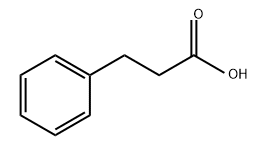| Description | 3-Phenylpropionic acid is a carboxylic acid that belongs to the class of phenylpropanoids. Also referred as hydrocinnamic acid, the chemical is a white crystalline solid with a sweet fatty smell of rose musk cinnamon at room temperature. 3-Phenylpropionic acid is soluble in both water and alcohol. It is widely used in food additives, cosmetics, and pharmaceuticals. |
| Preparation | Hydrogenation of cinnamic acid is used in the preparation of 3-Phenylpropionic acid. Initially, the chemical was prepared by reduction with sodium amalgam in water by electrolysis. |
| Uses | Food Industry
3-Phenylpropionic acid is utilized in the food industry as a preservative as well as to maintain the original quality of aroma of frozen foods. It is also used for flavoring and restoring original color to food. 3-Phenylpropionic acid is added to shelved foods to prevent microorganisms from deteriorating the food. It also acts as an antioxidant to prolong the life of foodstuff in shelves. 3-Phenylpropionic acid is also used as a food sweetener.
3-Phenylpropionic acid acts as an emulsifier as it can keep water and oil mixtures separated. 3-Phenylpropionic acid can be added in food for technological reasons in wide range such as processing, manufacturing, packaging, treatment, transportation, and storage.
Cosmetics
3-Phenylpropionic acid is used in beautifying products such as bath gels, detergent powders, and fabric softeners as it gives a floral scent. It is also used as a flavour for mouthwashes and toothpastes. |
| Chemical Properties | white to off-white crystalline mass, powder or crystals and/or chunk |
| Chemical Properties | 3-Phenylpropionic acid has a faint, sweet odor, somewhat balsamic and coumarin-like with a mildly sweet-sour, vanilla-like taste. |
| Occurrence | Reported found in raspberry, guava fruit, Vitis vinifera L., papaya, strawberry fruit, cinnamon, cassia leaf, cheddar cheese, cocoa, beer, cognac, white wine, red wine, special wine, rose apple, mushroom, cloudberry, Boletus edulis, fresh mango, licorice and labdanum. |
| Uses | Used in the compositions for the treatment of blood disorders using α-methylhydrocinnamic acid. |
| Uses | Hydrocinnamic acid is inhibitor of carboxypeptidase. Hydrocinnamic acid was used in the synthesis of three medium-chain acyl-Coenzyme A?s i.e. 3-phenylpropionyl-CoA from mixed anhydrides of fatty acids. |
| Uses | Hydrocinnamic acid was used in the synthesis of three medium-chain acyl-Coenzyme A′s i.e. 3-phenylpropionyl-CoA from mixed anhydrides of fatty acids. |
| Preparation | By reduction of cinnamic acid using sodium amalgam. |
| Definition | ChEBI: A monocarboxylic acid that is propionic acid substituted at position 3 by a phenyl group. |
| Synthesis Reference(s) | Tetrahedron Letters, 29, p. 5599, 1988 DOI: 10.1016/S0040-4039(00)80822-9 |
| General Description | Hydrocinnamic acid forms complexes with uranium(VI) and has been investigated in aqueous solution by attenuated total reflection fourier transform infrared spectroscopy. Hydrocinnamic acids are the major rhizospheric compounds with known growth regulatory activity. |
| Purification Methods | Crystallise the acid from *benzene, CHCl3 or pet ether (b 40-60o). Dry it in a vacuum. [Beilstein 9 H 508.] |
